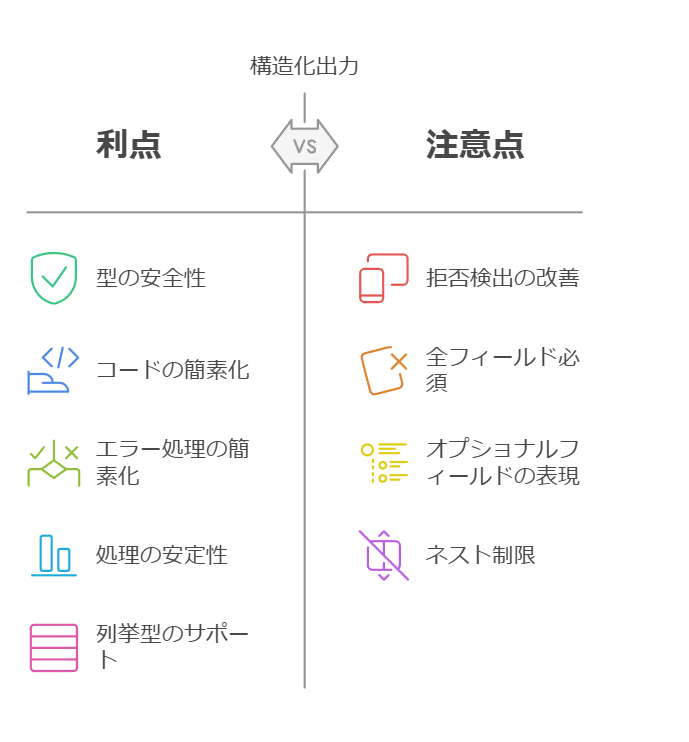はじめに

アプリケーションの信頼性を向上させる
OpenAIの新機能「Structured Outputs」を実際に触ってみた備忘録です。この機能は、LLMの出力を指定したJSONスキーマに厳密に従わせることができるため、安定したアプリケーション開発に非常に役立ちます。
「こんな感じのJSONで返してね」というプロンプトを書く必要はほぼなくなります。スキーマを定義することで、指定した構造に従った応答を得られる信頼性が大幅に向上します。
Structured Outputsとは?

Structured Outputsは、モデルが指定されたJSONスキーマに従った応答を生成する信頼性を大幅に高める機能です。従来のJSON modeの進化版と考えるとわかりやすいでしょう。
JSON modeとの違い
| 機能 | Structured Outputs | JSON Mode |
|---|---|---|
| 有効なJSONを出力 | ✅ | ✅ |
| スキーマに準拠 | ✅ | ❌ |
| 対応モデル | gpt-4o-mini, gpt-4o-2024-08-06以降 | gpt-3.5-turbo, gpt-4-* and gpt-4o-* models |
従来のJSON modeでは「JSONとして有効な出力」を保証するだけで、特定のスキーマに準拠することは保証されませんでした。Structured Outputsでは、必要なフィールドが必ず含まれ、余計なフィールドが含まれないことが保証されます。
新しいResponses APIを使ってみる
最近リリースされた「Responses API」を使うと、Structured Outputsをよりシンプルに扱えます。早速試してみましょう。
環境準備
Google Colabで試す場合は以下のようなセットアップが必要です:
# パッケージのインストール
!pip install -U openai openai-agents
# 環境変数の準備 (左端の鍵アイコンでOPENAI_API_KEYを設定)
import os
from google.colab import userdata
os.environ["OPENAI_API_KEY"] = userdata.get("OPENAI_API_KEY")
# クライアントの準備
from openai import OpenAI
client = OpenAI()
カレーコメント分析の実装例
例として、SNSのカレーに関するコメントを分析し、情報をグラフ構造に格納するアプリケーションを考えてみます。
実装コード
まず、簡易的なグラフ構造クラスを実装します:
class SimpleGraph:
def __init__(self):
self.nodes = {}
self.edges = {}
def add_node(self, node_id, node_type, properties=None):
if properties is None:
properties = {}
self.nodes[node_id] = {
"type": node_type,
"properties": properties
}
print(f"ノード追加: {node_id} ({node_type})")
def add_edge(self, source_id, target_id, edge_type, properties=None):
if properties is None:
properties = {}
edge_id = f"{source_id}_{target_id}_{edge_type}"
self.edges[edge_id] = {
"source": source_id,
"target": target_id,
"type": edge_type,
"properties": properties
}
print(f"エッジ追加: {source_id} --[{edge_type}]--> {target_id}")
def display(self):
print("\n=== ノード ===")
for node_id, node_data in self.nodes.items():
print(f"{node_id} ({node_data['type']}): {node_data['properties']}")
print("\n=== エッジ ===")
for edge_id, edge_data in self.edges.items():
print(f"{edge_data['source']} --[{edge_data['type']}]--> {edge_data['target']}: {edge_data['properties']}")
次に、カレーコメント分析クラスを実装します:
class CurryCommentAnalyzer:
def __init__(self):
from openai import OpenAI
self.client = OpenAI()
self.graph = SimpleGraph() # 簡易的なグラフ構造
def add_comment(self, user: str, comment: str):
import json
# スキーマの準備
schema = {
"format": {
"type": "json_schema",
"name": "curry_analysis",
"schema": {
"type": "object",
"properties": {
"restaurant": {"type": "string"},
"menu_item": {"type": "string"},
"ingredients": {
"type": "array",
"items": {"type": "string"}
},
"sentiment": {
"type": "string",
"enum": ["ポジティブ", "ネガティブ", "中立"]
},
"rating": {"type": ["number", "null"]}
},
"required": ["restaurant", "menu_item", "ingredients", "sentiment", "rating"],
"additionalProperties": False
},
"strict": True
}
}
# 入力メッセージの準備
messages = [
{"role": "developer", "content": """
カレーに関する情報を抽出します。
抽出する情報:
1. 言及されているレストラン名
2. 新しいメニュー項目
3. 使用されている材料
4. コメントの感情(ポジティブ/ネガティブ/中立)
5. 評価(もし明示されていれば、なければnull)
"""},
{"role": "user", "content": f"ユーザー: {user}\nコメント: {comment}"}
]
try:
# Responses APIを使用した推論の実行
response = self.client.responses.create(
model="gpt-4o",
input=messages,
text=schema
)
# JSONとして解析
analysis = json.loads(response.output_text)
# グラフへの追加処理
if analysis['restaurant']:
self.graph.add_node(analysis['restaurant'], "Restaurant", {"name": analysis['restaurant']})
self.graph.add_edge(user, analysis['restaurant'], "COMMENTED_ON", {
"sentiment": analysis.get('sentiment', ''),
"rating": analysis.get('rating', '')
})
if analysis['menu_item']:
self.graph.add_node(analysis['menu_item'], "MenuItem", {"name": analysis['menu_item']})
if analysis['restaurant']:
self.graph.add_edge(analysis['restaurant'], analysis['menu_item'], "HAS_MENU_ITEM")
if analysis['ingredients']:
for ingredient in analysis['ingredients']:
self.graph.add_node(ingredient, "Ingredient", {"name": ingredient})
if analysis['menu_item']:
self.graph.add_edge(analysis['menu_item'], ingredient, "CONTAINS")
print(f"コメントを分析し、グラフに追加しました: {analysis}")
return analysis
except Exception as e:
print(f"Error: {e}")
return None
使用例
# 実行例
analyzer = CurryCommentAnalyzer()
# テストケース
test_cases = [
{
"user": "田中",
"comment": "昨日カレーハウスAで食べたビーフカレーが美味しかった!特に玉ねぎとニンジンがたっぷり入っていて、スパイスも効いていた。★★★★☆の4点あげたい!"
},
{
"user": "佐藤",
"comment": "スパイスキングのチキンカレーは辛すぎて食べられなかった。ターメリックとチリパウダーの味が強すぎる。次は選ばないかな..."
}
]
# テスト実行
for case in test_cases:
analyzer.add_comment(case['user'], case['comment'])
# グラフの表示
analyzer.graph.display()
実行結果
以下のような出力が得られます:
ノード追加: カレーハウスA (Restaurant)
エッジ追加: 田中 --[COMMENTED_ON]--> カレーハウスA
ノード追加: ビーフカレー (MenuItem)
エッジ追加: カレーハウスA --[HAS_MENU_ITEM]--> ビーフカレー
ノード追加: 玉ねぎ (Ingredient)
エッジ追加: ビーフカレー --[CONTAINS]--> 玉ねぎ
ノード追加: ニンジン (Ingredient)
エッジ追加: ビーフカレー --[CONTAINS]--> ニンジン
ノード追加: スパイス (Ingredient)
エッジ追加: ビーフカレー --[CONTAINS]--> スパイス
コメントを分析し、グラフに追加しました: {'restaurant': 'カレーハウスA', 'menu_item': 'ビーフカレー', 'ingredients': ['玉ねぎ', 'ニンジン', 'スパイス'], 'sentiment': 'ポジティブ', 'rating': 4}
ノード追加: スパイスキング (Restaurant)
エッジ追加: 佐藤 --[COMMENTED_ON]--> スパイスキング
ノード追加: チキンカレー (MenuItem)
エッジ追加: スパイスキング --[HAS_MENU_ITEM]--> チキンカレー
ノード追加: ターメリック (Ingredient)
エッジ追加: チキンカレー --[CONTAINS]--> ターメリック
ノード追加: チリパウダー (Ingredient)
エッジ追加: チキンカレー --[CONTAINS]--> チリパウダー
コメントを分析し、グラフに追加しました: {'restaurant': 'スパイスキング', 'menu_item': 'チキンカレー', 'ingredients': ['ターメリック', 'チリパウダー'], 'sentiment': 'ネガティブ', 'rating': None}
ポイント解説
1. スキーマの定義
Structured Outputsの核となるのはスキーマ定義です。
schema = {
"format": {
"type": "json_schema",
"name": "curry_analysis", # スキーマの名前(任意)
"schema": {
"type": "object",
"properties": {
# プロパティの定義
"restaurant": {"type": "string"},
"menu_item": {"type": "string"},
"ingredients": {
"type": "array",
"items": {"type": "string"}
},
"sentiment": {
"type": "string",
"enum": ["ポジティブ", "ネガティブ", "中立"] # 列挙型の指定も可能
},
"rating": {"type": ["number", "null"]} # 複数の型を許容
},
"required": ["restaurant", "menu_item", "ingredients", "sentiment", "rating"], # 必須フィールド
"additionalProperties": False # 追加のプロパティを許可しない
},
"strict": True # 厳密モードを有効化
}
}
ここで重要なのは:
-
required:必須フィールドの指定 -
additionalProperties: false:追加のプロパティを禁止 -
strict: true:厳密モードの有効化 -
enum:許容される値の列挙 -
type: ["number", "null"]:複数の型を許容する場合の記法
2. Responses APIの使用
response = self.client.responses.create(
model="gpt-4o",
input=messages, # 入力メッセージのリスト
text=schema # スキーマ定義
)
# 結果はoutput_textから取得
analysis = json.loads(response.output_text)
従来のChat Completions APIとの主な違いは:
-
client.chat.completions.create()→client.responses.create() -
messages→input -
response_format→text -
response.choices[0].message.content→response.output_text
3. developerロールの活用
messages = [
{"role": "developer", "content": "カレーに関する情報を抽出します..."},
{"role": "user", "content": f"ユーザー: {user}\nコメント: {comment}"}
]
従来のAPIのsystemロールに相当するdeveloperロールが新しく導入されています。これにより、システム指示とユーザー入力の区別がより明確になります。
Structured Outputsの利点
- 型の安全性: スキーマ通りの応答が保証されるため、型チェックが不要になる
- コードの簡素化: 「JSONで返してね」といったプロンプトが不要
- エラー処理の簡素化: 不正なJSON形式を考慮する必要がない
- 処理の安定性: 常に同じ構造の出力が得られる
- 列挙型のサポート: 値の選択肢を制限できる
- 拒否検出の改善: 拒否応答も専用フィールドで検出可能
注意点
-
対応モデル: 現時点では
gpt-4o-mini、gpt-4o-2024-08-06以降のモデルでのみサポート -
全フィールド必須: スキーマ内のすべてのフィールドは
requiredとして指定する必要がある -
オプショナルフィールドの表現: オプショナルにしたい場合は
nullを許容する型として定義する - ネスト制限: オブジェクトは5レベルまでのネスト、100プロパティまで
従来のChat Completions APIとの比較
従来のAPIでの実装例と比較してみましょう:
# 従来のChat Completions API
response = client.chat.completions.create(
model="gpt-4o",
messages=[
{"role": "system", "content": "カレーに関する情報を抽出します..."},
{"role": "user", "content": f"ユーザー: {user}\nコメント: {comment}"}
],
response_format={
"type": "json_schema",
"schema": {
"type": "object",
"properties": {
# スキーマ定義
},
"required": ["restaurant", "menu_item", "ingredients", "sentiment", "rating"],
"additionalProperties": False
}
}
)
analysis = json.loads(response.choices[0].message.content)
まとめ
Structured Outputsは、OpenAIのモデルを実際のアプリケーション開発で使用する際の信頼性を大幅に向上させる機能です。新しいResponses APIと組み合わせることで、より直感的かつ安定した実装が可能になります。
特に以下のようなケースで有用です:
- 構造化されたデータを抽出する場合
- データベースに格納するデータを生成する場合
- 特定のフォーマットを厳守する必要がある場合
- UIに表示するための一貫した構造が必要な場合
参考リンク
※本記事は2025年3月時点の情報に基づいています。API仕様は変更される可能性がありますので、最新の公式ドキュメントを参照してください。
過去記事
以前の記事では、プロンプトエンジニアリングで「JSON形式で回答してください」と指示してデータを抽出していました。本記事では、その手法をOpenAIの新機能「Structured Outputs」で置き換え、より型安全で一貫性のある実装方法を試してみました。



